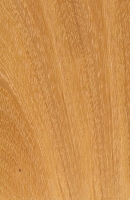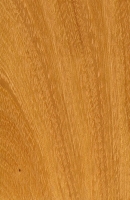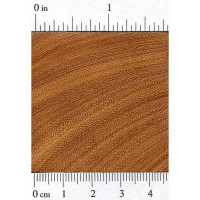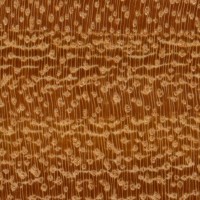 |
Common Name(s): Argentine Osage Orange, Fustic
Scientific Name: Maclura tinctoria (syn. Chlorophora tinctoria, Morus tinctoria) Distribution: Tropical America (West Indies, Central and South America) Tree Size: 60-80 ft (18-25 m) tall, 2-3 ft (.6-1.0 m) trunk diameter Average Dried Weight: 57 lbs/ft3 (910 kg/m3) Specific Gravity (Basic, 12% MC): .75, .91 Janka Hardness: 2,380 lbf (10,590 N) Modulus of Rupture: 19,560 lbf/in2 (134.9 MPa) Elastic Modulus: 2,160,000 lbf/in2 (14.90 GPa) Crushing Strength: 11,710 lbf/in2 (80.8 MPa) Shrinkage: Radial: 3.4%, Tangential: 5.4%, Volumetric: 7.8%, T/R Ratio: 1.6 |
Color/Appearance: Heartwood is golden to bright yellow, which almost certainly ages to a darker medium brown with time: primarily due to exposure to UV light. See the article Preventing Color Changes in Exotic Woods for more details. A Guatemalan variant exists which is sometimes called “Guatemalan Tigerwood” or “Mora” (not to be confused with Mora excelsa, which also goes by the common name of Mora) which is light to medium reddish brown, with streaks of lighter and darker material.
Grain/Texture: Has a straight to interlocked grain, with a fine to medium texture.
Endgrain: Diffuse-porous; large to very large pores in no specific arrangement; commonly in radial multiples of 2-3; tyloses and other deposits common; growth rings may be distinct due to seemingly marginal parenchyma; narrow to medium rays visible without lens, spacing normal to fairly close; parenchyma banded, paratracheal parenchyma vasicentric, lozenge, winged, and confluent.
Rot Resistance: Argentine Osage Orange is very durable and has good weathering characteristics; it is also resistant to termites.
Workability: Working this wood can be difficult due to its hardness and density, though it is reported to have little dulling effect on cutting edges. It turns well, and also takes stains, glues and finishes well.
Odor: No characteristic odor.
Allergies/Toxicity: Sap has been reported to cause dermatitis. See the articles Wood Allergies and Toxicity and Wood Dust Safety for more information.
Pricing/Availability: Argentine Osage Orange should be moderately priced for an imported hardwood. Prices are likely to be comparable to the domestic species of Osage Orange.
Sustainability: This wood species is not listed in the CITES Appendices or on the IUCN Red List of Threatened Species.
Common Uses: Heavy construction (within the tree’s natural range), flooring, furniture, turnings, and other small specialty wood items.
Comments: Argentine Osage Orange is known by a host of names throughout its natural range in South America, though historically the wood has been known in English as Fustic. However, because of its close relation and similar working properties to Osage Orange (Maclura pomifera) found in North America, merchants of imported hardwoods have referred to this wood as Argentine Osage Orange. This imported wood tends to be available in larger sizes, and with less knots or twists than the domestic species. (Though it appears, at least on paper, that Maclura pomifera has a lower modulus of elasticity, making it more flexible—which may be good or bad depending upon the intended application.)
Perhaps one of the most confusing names in modern hardwood commerce is the selling of a Guatemalan variety of Osage Orange—which looks vastly different than the traditional yellow color—that’s being marketed as “Mora.” Unfortunately, the common name Mora has traditionally been used for an unrelated wood found in northern South America (not found in Guatemala) known by the scientific name Mora excelsa.
Argentine Osage Orange is sometimes called Fustic because the wood contains a yellow dye called fustic—which has historically been used in making brown, yellow, and green colored dyes for fabric.








I use Argentine Osage Orange for flexible atlatl shafts 18 inches long, 1 inch wide, by 1/4 inch thick, attached to an 11 inch long handle (overlapped by 4 inches) (total length 22 1/2 inches) as this wood in these dimensions provide just enough flexibility to act as a shock absorber during the throwing motion. Other than rounding off the edges, no thinning of the surface is needed. I use this atlatl to launch 7 foot long, 5 1/2 ounce flexible darts 15 to 25 meters distances. See World Atlatl Association ISAC scores.
If kitchen counter top made from this wood, will water bring out the yellow dye, an unwanted event?
I think it would depend on the type of finish on the wood, and the integrity of the finish itself. I’d guess that a film building finish would effectively protect against any discoloration or leaching of color. But if the finish were to develop deep scratches or wear away with time, it could be a problem.
use Tung oil and sand it back 6 times, let it sit for 60 days and then use a good furniture wax and it’ll never bleed out, if you get a scratch use rub some Tung oil in it. All of our furniture is done that way and it’s worked well for decades.
I have made several bamboo backed longbows from this wood and they shoot quite well.
Hi Mariano. The common name in Argentina is “mora amarilla”. Trees grow at Misiones, Salta and Tucumán provinces.
Common name of the tree? I’m in Argentina, and don’t know trees by latin name.